If Hymans Know the Day They Die and Someone Is Born With a You Dont
Nosotros're born, we alive, we die. Few things are so concrete. And still, while we swap countless stories about the start of life, the terminate is a discipline we're less inclined to talk almost.
Conversations about expiry – what it is, what it looks like – are scarce until nosotros suddenly face it caput on, often for the first time with the loss of a loved one.
"We hold a lot of anxiety about what expiry ways and I think that'southward just office of the homo feel," says Acquaintance Professor Marking Boughey, director of palliative medicine at Melbourne's St Vincent'south Hospital. "Some people just really push it away and don't call up about information technology until information technology's immediately in front of them."
Just it doesn't need to be this way, he says.
"The more people engage and understand decease and know where it'southward heading ... the better prepared the person is to be able to let go to the process, and the amend prepared the family is to reconcile with information technology, for a more peaceful death."
Of course, not everyone ends upwardly in palliative care or even in a hospital. For some people, expiry can be shockingly sudden, as in an blow or from a cardiac arrest or massive stroke. Expiry tin can follow a brief decline, as with some cancers; or a prolonged one, equally with frailty; or information technology tin come afterwards a series of serious episodes, such as heart failure. And dissimilar illnesses, such as dementia and cancer, can too crusade detail symptoms prior to death.
But there are key physical processes that are commonly experienced by many people as they dice – whether from "old age", or indeed from cancer, or even following a major concrete trauma.
What is the procedure of dying? How can y'all prepare for it? And how should yous be with someone who is nearing the end of their life?
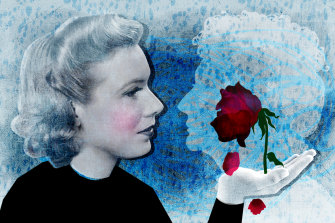
Analogy: Dionne Gain Credit:
What are the earliest signs a person is going to die?
The indicate of no return, when a person begins deteriorating towards their concluding breath, can beginning weeks or months earlier someone dies.
Professor Boughey says refractory symptoms – stubborn and irreversible despite medical treatment – offer the earliest signs that the dying process is outset: breathlessness, severe appetite and weight loss, fluid retentivity, fatigue, drowsiness, delirium, jaundice and nausea, and an overall drib in concrete function.
Elementary actions, such equally going from a bed to a chair, can become exhausting. A dying person ofttimes starts to withdraw from the news, some activities and other people, to talk less or have trouble with chat, and to sleep more.
This all ties in with a drop in energy levels acquired past a deterioration in the body'southward brain office and metabolic processes.
Predicting exactly when a person will die is, of course, nearly impossible and depends on factors ranging from the health issues they accept to whether they are choosing to take more medical interventions.
"The journey for everyone towards dying is so variable," Professor Boughey says.
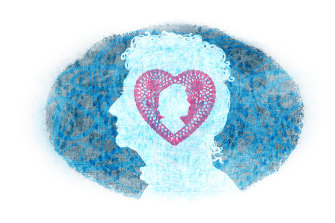
Illustration: Dionne Gain Credit:
What happens in someone'due south last days?
As the body continues to wind down, various other reflexes and functions will too irksome. A dying person will become progressively more drawn, their sleep-wake patterns more random, their coughing and swallowing reflexes slower. They will start to respond less to verbal commands and gentle bear upon.
Reduced blood flow to the brain or chemical imbalances can also cause a dying person to get disoriented, dislocated or discrete from reality and time. Visions or hallucinations often come into play.
"A lot of people have hallucinations or dreams where they see loved ones," Professor Boughey says. "Information technology's a real signal that, even if we tin't see they're dying, they might exist."
Only Professor Boughey says the hallucinations often help a person die more peacefully so it's best not to "correct" them. "Visions, especially of long-gone loved ones, can be comforting."
People go no longer interested in eating … they physically don't desire to.
Instead of merely sleeping more, the person's consciousness may begin to fluctuate, making them virtually impossible to wake at times, even when there is a lot of stimulation effectually them.
With the slowing in blood circulation, body temperature can begin to seesaw, so a person can be cool to the touch at one bespeak and so hot afterward on.
Their senses of taste and smell diminish. "People become no longer interested in eating … they physically don't want to," Professor Boughey says.
This means urine and bowel movements become less frequent, and urine volition be much darker than usual due to lower fluid intake. Some people might start to experience incontinence equally muscles deteriorate only absorbent pads and sheets help minimise discomfort.
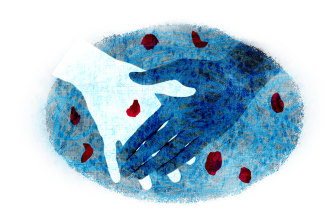
Illustration: Dionne Gain Credit:
What happens when decease is just hours or minutes abroad?
Equally decease nears, it's very common for a person'due south breathing to modify, sometimes slowing, other times speeding upward or becoming noisy and shallow. The changes are triggered by reduction in claret flow, and they're not painful.
Some people will feel a gurgle-similar "death rattle". "Information technology's really some secretions sitting in the dorsum of the throat, and the trunk can no longer shift them," Professor Boughey says.
An irregular breathing blueprint known every bit Cheyne-Stokes is also frequently seen in people approaching decease: taking 1 or several breaths followed by a long break with no breathing at all, then some other breath.
"It doesn't happen to everybody, just it happens in the last hours of life and indicates dying is really front and centre. It ordinarily happens when someone is profoundly unconscious," Professor Boughey says.
Restlessness affects nearly half of all people who are dying. "The confusion [experienced earlier] can cause restlessness right at the cease of life," Professor Boughey says. "Information technology'due south just the natural physiology, the encephalon is trying to go along operation."
Apportionment changes also mean a person's heartbeat becomes fainter while their skin can become mottled or pale grayness-blue, specially on the knees, feet and hands.
Professor Boughey says more perspiration or clamminess may be present, and a person's eyes can begin to tear or appear glazed over.
Gradually, the person drifts in and out or slips into consummate unconsciousness.
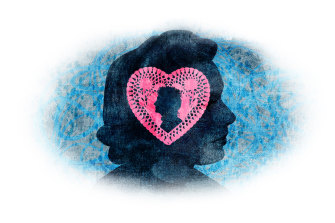
Analogy: Dionne Gain Credit:
How long does dying accept? Is it painful?
UNSW Professor of Intensive Intendance Ken Hillman says when he is treating someone who is going to die, 1 of the starting time questions he is inevitably asked is how long the person has to live.
"That is such a difficult question to reply with accuracy. I always put a passenger at the end maxim it's unpredictable," he says.
"Even when we stop treatment, the body can draw on reserves we didn't know information technology had. They might live another twenty-four hours, or two days, or two weeks. All we know is, in long-term speaking, they certainly are going to die very soon."
Simply he stresses that nearly expected deaths are not painful. "You gradually become confused, you lose your level of consciousness, and you fade away."
Should there exist any pain, information technology is relieved with medications such equally morphine, which do non interfere with natural dying processes.
"If there is any sign of pain or discomfort, we would always reassure relatives and carers that they will die with nobility, that we don't stop caring, that we know how to care for it and nosotros continue treatment."
There tin can exist a real sense of readiness, similar they're in this prophylactic cocoon, in the last day or ii of life.
Professor Boughey agrees, saying the hurting instead tends to sit with the loved ones.
"For a dying person there can be a real sense of readiness, like they're in this safe cocoon, in the last day or two of life."
Professor Boughey believes there is an chemical element of "letting go" to death.
"Nosotros see situations where people seem to hang on for certain things to occur, or to see somebody meaning, which so allows them to permit go," he says.
"I've seen someone talk to a sibling overseas and so they put the phone downward and die."

Analogy: Dionne Proceeds Credit:
How tin can you 'set' for expiry?
Firstly, there is your frame of heed. In thinking near death, it helps to compare it to birth, Professor Boughey says.
"The fourth dimension of dying is similar nascence, it can happen over a day or 2, but information technology'south actually the fourth dimension leading up to information technology that is the most critical part of the equation," he says.
With nascency, what happens in the ix months leading to the day a baby is born – from the medico's appointments to the birth classes – can brand a huge difference. And Professor Boughey says it's "absolutely similar" when someone is facing the end of life.
To Professor Hillman, better understanding the dying process tin help us end treating death as a medical problem to be fixed, and instead every bit an inevitability that should be as comfortable and peaceful as possible.
People are not being asked enough where they desire to exist cared for and where they want to dice.
And so at that place are some practicalities to discuss. Seventy per cent of Australians would adopt to dice at home only, according to a 2018 Productivity Commission report, less than 10 per cent do. Instead, about half die in hospitals, ending up there considering of an illness triggered by disease or age-related frailty (a small-scale percentage dice in accident and emergency departments). Another third die in residential aged care, according to data from the Australian Institute of Health and Welfare.
Professor Hillman believes decease is over-medicalised, particularly in one-time age, and he urges families to acknowledge when a loved one is dying and to hash out their wishes: where they desire to die, whether they want medical interventions, what they don't want to happen.
"[Discussing this] can empower people to brand their own decisions virtually how they die," says Professor Hillman.
Palliative Care Nurses Australia president Jane Phillips says someone's finish-of-life preferences should be understood early on but also revisited throughout the dying process as things tin can change. With the correct support systems in place, dying at home can be an selection.
"People are non being asked enough where they desire to be cared for and where they want to dice," Professor Phillips says. "One of the most important things for families and patients is to have conversations about what their care preferences are."

Illustration: Dionne Proceeds Credit:
How tin y'all aid a loved one in their final hours?
Studies show that hearing is the last sense to fade, so people are urged to go along talking calmly and reassuringly to a dying person as it can bring not bad comfort even if they practise not appear to exist responding.
"Many people will be unconscious, not able to be roused – but be mindful they can still hear," Professor Phillips says.
"Every bit a nurse caring for the person, I let them know when I'g there, when I'1000 about to touch them, I proceed talking to them. And I would advise the aforementioned to the family equally well."
On his ICU ward, Professor Hillman encourages relatives to "non be afraid of the person on all these machines".
"Sit next to them, hold their hands, stroke their forehead, talk to them about their garden and pets and assume they are listening," he says.
Hearing is the last sense to fade so people are urged to keep talking calmly and reassuringly to a dying person.
Remember that while the concrete or mental changes can be deplorable to observe, they're not generally troubling for the person dying. Once families accept this, they can focus on existence with their dying loved one.
Professor Boughey says people should think about how the person would habitually like them to deed.
"What would you lot normally practice when you're caring for your loved one? If yous like to hold and touch and communicate, do what you lot would commonly practise," he says.
Other things that tin comfort a dying person are playing their favourite music, sharing memories, moistening their rima oris if information technology becomes dry, roofing them with light blankets if they get cold or damp cloths if they experience hot, keeping the room air fresh, repositioning pillows if they get uncomfortable and gently massaging them. These gestures are unproblematic simply their significance should not be underestimated.
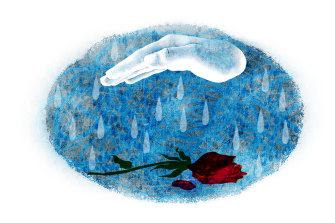
Illustration: Dionne Gain Credit:
What is the moment of decease?
In Australia, the moment of decease is defined as when either blood apportionment or brain function irreversibly cease in a person. Both will eventually happen when someone dies, it'southward just a matter of what happens first.
Encephalon expiry is less common, and occurs subsequently the brain has been so badly damaged that it swells, cutting off blood catamenia, and permanently stops, for example following a head injury or a stroke.
The more widespread type of expiry is circulatory death, where the heart comes to a standstill.
Later circulation ceases, the brain and so becomes deprived of oxygenated blood and stops functioning.
The precise fourth dimension it takes for this to happen depends on an individual'southward prior condition, says intensive intendance specialist Dr Matthew Anstey, a clinical senior lecturer at University of Western Commonwealth of australia.
"Allow's say you starting time slowly getting worse and worse, where your blood pressure is gradually falling before it stops, in that situation your encephalon is vulnerable already [from reduced claret flow], and so information technology won't have much to stop the encephalon," Dr Anstey says.
The brain remains momentarily active after a circulatory expiry.
"Simply if it'due south a sudden cardiac abort, the brain could go on a bit longer. It can take a minute or two minutes for brain cells to dice when they take no blood flow."
This means, on some level, the encephalon remains momentarily active later on a circulatory death. And while inquiry in this space is ongoing, Dr Anstey does not believe people would exist witting at this point.
"In that location is a divergence between consciousness and some degree of cellular function," he says. "I retrieve consciousness is a very complicated higher-order office."
Cells in other organs – such as the liver and kidneys – are comparatively more resilient and can survive longer without oxygen, Dr Anstey says. This is essential for organ donation, as the organs can remain viable hours afterward death.
In a palliative intendance setting, Professor Boughey says the encephalon usually becomes inactive around the same time as the middle.
Only he says that, ultimately, it is the brain'southward gradual switching off of various processes – including animate and circulation – that leads to about deaths.
"Your whole metabolic organisation is run out of the brain… [It is] directing everything."
He says it's why sometimes, only earlier death, a person can snap into a moment of clarity where they say something to their family. "Information technology tin exist very profound ... it's like the brain trying one more time."

Illustration: Dionne Proceeds Credit:
What does a dead person look like?
"There is a perceptible change between the living and dying," Professor Boughey says.
"Often people are watching the breathing and don't see it. But there is this change where the torso no longer is in the presence of the living. It's nonetheless, its color changes. Things just stop. And it's usually very, very gentle. It's not dramatic. I reassure families of that beforehand."
A typical sign that expiry has just happened, apart from an absence of breathing and heartbeat, is stock-still pupils, which indicate no brain activity. A person's eyelids may besides be half-open, their skin may be stake and waxy-looking, and their mouth may fall open as the jaw relaxes.
Professor Boughey says that but very occasionally will there be an unpleasant occurrence, such equally a person vomiting or releasing their bowels but, in most cases, expiry is peaceful.
And while nigh loved ones want to exist present when death occurs, Professor Boughey says information technology's important not to feel guilty if you're not considering information technology can sometimes happen very of a sudden. What's more important is beingness present during the lead-upward.
What happens next?
Once a person dies, a medical professional person must verify the death and sign a document confirming it.
"It's absolutely critical for the family to see … because information technology signals very conspicuously the person has died," says Professor Boughey. "The family may not have started grieving until that point."
In some cases, organ and tissue donation occurs, but only if the person is eligible and wished to practice so. The complexity of the process means information technology usually just happens out of an intensive care ward.
You lot might feel despair, you might feel numb, y'all might feel relief. In that location is no right or wrong way to feel.
Professor Boughey stresses that an expected death is not an emergency – police and paramedics don't need to be called.
Later on the doctor'due south document is issued, a funeral company takes the dead person into their care and collects the information needed to register the expiry. They can as well aid with newspaper notices or flowers.
But all of this does not need to happen right away, Professor Boughey says. Do what feels correct. The moments after death can be tranquil, and y'all may only want to sit down with the person. Or y'all might desire to call others to come, or fulfil cultural wishes.
"There is no reason to have the trunk away suddenly," Professor Boughey says.
You might feel despair, you might experience numb, you might feel relief. There is no right or wrong way to experience. Every bit loved ones move through the grieving procedure, they are reminded back up is bachelor – be it from friends, family or health professionals.

Illustration: Dionne Gain Credit:
easterlingforer1944.blogspot.com
Source: https://www.smh.com.au/lifestyle/life-and-relationships/what-happens-as-we-die-20190809-p52fjy.html
0 Response to "If Hymans Know the Day They Die and Someone Is Born With a You Dont"
Post a Comment